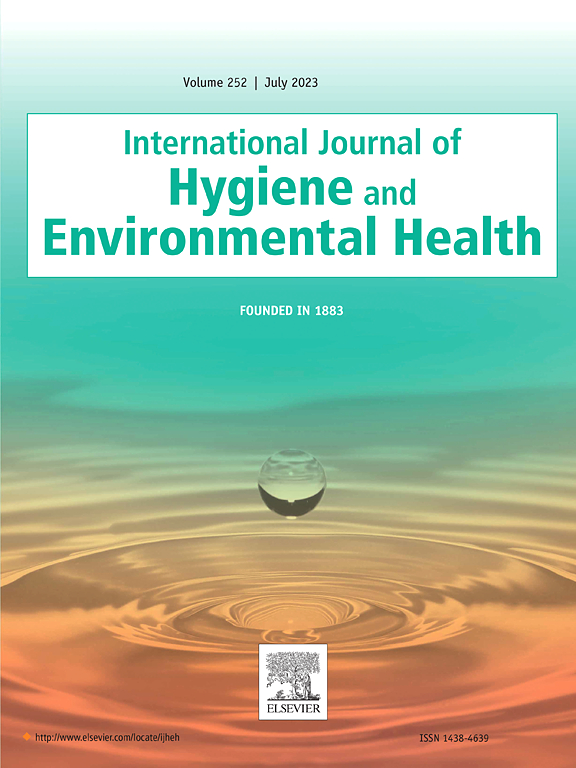Assessment of the fit and wearability of commercially available KN95 respirators for children in Indonesia and Nepal
IF 4.4
2区 医学
Q1 INFECTIOUS DISEASES
International journal of hygiene and environmental health
Pub Date : 2025-03-24
DOI:10.1016/j.ijheh.2025.114561
引用次数: 0
Abstract
The purpose of this study was to determine how well KN95 respirators, marketed for children, fit the faces of children aged 6–13 years old in two urban sites with elevated levels of air pollution: Kathmandu, Nepal and Bandung, Indonesia. The wearability of the tested respirators and the children's style preferences were also assessed.
Sixty children, 30 in each country, were recruited and were fit tested with three different ear loop respirators in two combinations (with and without an additional adjustable ear loop clip worn around the head). The fit factor for each respirator was determined using a modified fit test protocol for filtering face piece respirators using a TSI PortaCount™ Respirator Fit Tester 8048. Facial dimensions were measured using callipers. The wearability of the respirators and children's style preferences were assessed through questionnaires administered after the fit tests.
Most fit factors were less than 10, i.e. less than 90 % reduction in exposure. In both countries, using an additional ear loop clip was associated with increases in fit factor of 42 and 50 % for Indonesian and Nepalese respirators, respectively. There were no significant differences among the respirators for any of the perceptions: comfort, feeling hot, breathability, fit, embarrassment or appearance for either country. The appearance of the respirator was important to the children. Although the use of an additional ear loop clip improved the fit, the respirators were generally too large for the children's faces to achieve a good fit. Respirators marketed for children should be better designed to suit their facial dimensions.
评估印尼和尼泊尔市售KN95儿童口罩的适合性和可穿戴性
本研究的目的是确定KN95儿童口罩在两个空气污染水平较高的城市地区(尼泊尔加德满都和印度尼西亚万隆)对6-13岁儿童的面部贴合程度。测试口罩的可穿戴性和儿童的风格偏好也被评估。招募了60名儿童,每个国家30名,并对三种不同的耳套呼吸器进行了两种组合(头上戴有和不戴额外的可调节耳套夹)的适合性测试。使用TSI portaccount™呼吸器适配测试仪8048,使用改进的过滤式面罩适配测试方案确定每个呼吸器的适配系数。使用卡尺测量面部尺寸。在适合性测试后,通过问卷调查评估呼吸器的可穿戴性和儿童的风格偏好。大多数适宜因子小于10,即暴露减少小于90%。在这两个国家,使用额外的耳环夹分别使印度尼西亚和尼泊尔呼吸器的适合系数增加了42%和50%。两国的呼吸器在舒适度、热感、透气性、合身度、尴尬度和外观等方面都没有显著差异。呼吸器的外观对孩子们很重要。虽然使用额外的耳环夹改善了配合度,但对于儿童的面部来说,呼吸器通常太大,无法达到良好的配合度。为儿童销售的呼吸器应该更好地设计以适应他们的面部尺寸。
本文章由计算机程序翻译,如有差异,请以英文原文为准。
求助全文
约1分钟内获得全文
求助全文
来源期刊
CiteScore
11.50
自引率
5.00%
发文量
151
审稿时长
22 days
期刊介绍:
The International Journal of Hygiene and Environmental Health serves as a multidisciplinary forum for original reports on exposure assessment and the reactions to and consequences of human exposure to the biological, chemical, and physical environment. Research reports, short communications, reviews, scientific comments, technical notes, and editorials will be peer-reviewed before acceptance for publication. Priority will be given to articles on epidemiological aspects of environmental toxicology, health risk assessments, susceptible (sub) populations, sanitation and clean water, human biomonitoring, environmental medicine, and public health aspects of exposure-related outcomes.

 求助内容:
求助内容: 应助结果提醒方式:
应助结果提醒方式:


